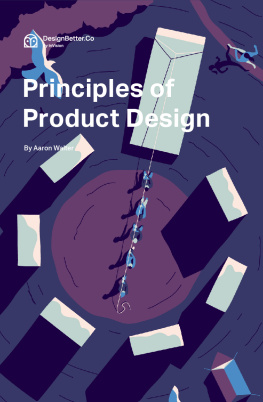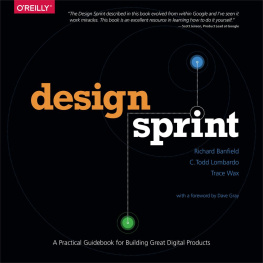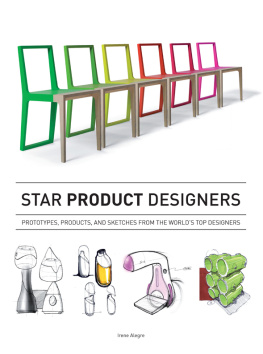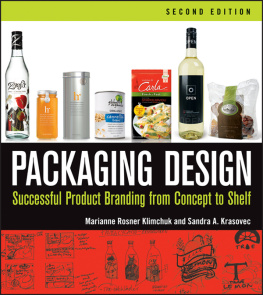DESIGN SPRINT
A Practical Guidebook for Building Great Digital Products
Richard Banfield
C.Todd Lombardo
Trace Wax
OREILLY
DESIGN
SPRINT
A Practical Guidebook for Building Great Digital Products
by Richard Banfield, C.Todd Lombardo and Trace Wax
Copyright 2015
Omnit laturestis evendis ciducimenes modi tem fuga. Et eostrum quibus nobitae. Nem auda is acepellut illora doluptibus adis ma cuptatur, voluptati dolorat iaerum dolorit aturerferit aut fugia doluptis non estisqui consequame ped maiorume perovit atempor ectasit ut et reptaquo quodis apernam, ut dis et aut versped et ut asinull essequatus volu
The product professional
This book is for you.
Youre the product person in your organization. You may have no one reporting to you. You might have 50 people in your product group. You might be responsible for the entire product. Maybe the design team doesnt report to you, neither do developers nor the marketing or the sales teams. Maybe youre in a startup without all those defined roles, and you wear a lot of hats. Maybe youre in a large enterprise organization that has each one defined to the nth degree. Maybe you are a product design freelancer. You might work in an agency as a consultant. You probably have read a blog post about this process. Maybe you even tried one yourself. Youre very likely wondering how your unique needs will work with Design Sprints and are seeking more information than you can find in a few blog posts.
If any of these descriptions sound familiar, then this book was intended for you.
Objectives
There were three things that drove us to create this book. Reducing the amount of waste, providing practical applications to the process for a range of companies and improving the accessibility of Design Sprints. We are attracted to the Design Sprint process because its a simple way to prototyping and testing just about any product in a week, or less.
Like most digital product managers, we witnessed the creation of far too many products that didnt have a good market fit. These misfires waste money and energy but worst of all, they waste time For many companies (especially startups), getting a product to market quickly is the difference between life and death..
The hardest part of creating a product is to get to market and get traction before the opportunity disappears. For larger companies, and the design firms that serve them, the challenge is often more complicated than just time and cash; theres also organizational politics to deal with.
Might there be a process out there that helps control costs, reduces the waste of going in the wrong direction, and helps keep the peace? Could such a fabled thing exist in the chaotic world of product design?
The digital product design landscape
Although digital products have only been with us for a few decades, they have become the dominant way we consume information and communication. At the writing of this book, there were 500+ new apps being released into the wild every single day! That doesnt even include the related physical products and services that accompany those apps. At that rate, its hard to grasp the effort and time needed to make so many products. Let alone understand the wasted hours and dollars.
Youd think that digital products would be easier to build than physical products. CEOs and founders often cant understand why their investments in digital products arent paying off. The path to creating digital products appears so much easier no injection-molding, no flying to China to meet suppliers, hardly a whiff of dirty labor at all. Building a digital product is, in fact, relatively cheap and quick. But building the right product to win in the marketplace is as hard and grueling as ever. This is because the key components to digital products are not pixels and code, but rather people, time, and process. And people are always going to be complicated.
If youre product lead, time (or lack thereof), is what keeps you up at night. Having collectively worked on over eight hundred digital products, we feel your pain. The frustration and the consequences of losing ground to bad decisions and missed opportunities was the primary motivation for writing this book.
We will focus on the realities of designing digital products, and lay out a practical guide to implementing the Design Sprint principles and techniques. Knowing full well that there is no single way to creating the perfect product, we dont want to sound prescriptive. However, having a disciplined and proven process wins out over winging it, every time. This book will help almost anyone working on digital products go from knowledge to action.
Another distinguishing element of this book is that we discuss how the Design Sprint fits into the real world. Unlike in controlled environments or case studies, things dont always align. In the turbulent reality of our lives, its hard to find five days of uninterrupted time. Its hard to get the attention of the executives. Its hard to find testing subjects that fit your exact target profile. This book was written for the sticky, messy, chaotic world we all live in. We interviewed dozens of product designers just like you, and we saw a huge variety in the way Design Sprints were being used. In fact, no two organizations we spoke with do it the same way. Google Ventures evangelizes a five-day process while Intrepid Pursuits does a Design Sprint over 4 to 6 weeks. Agencies like fresh tilled soil have undertaken sprints that take up to two weeks. At the other end of the spectrum, a Design Sprint can be run every other day, rather in blocks of one to two full days. At larger companies like Constant Contact, a Design Sprint can last from a half-day up to 9 days, depending on the project. The Design Sprint is a framework, not a set of rules. Well show you several ways to mold the Design Sprint to meet your specific needs.
As flexible as Design Sprints are, we like the approach better than most design processes for one simple reason: its as far from the gut feeling approach employed by many product designers as you can get. As Patrick Solvabarro, the CEO of Upward Labs, a Constant Contact InnoLoft startup resident said, These Design Sprints are a lot like mini science experiments. We like that comparison. The scientific process has successfully given us a model to get our ideas out of our heads (a hypothesis) and test them against the pressures of the big bad world (experimentation) so that we can either validate the hypothesis or figure out whats not working. Creativity is never the product of lightning-strike inspirations or flashes of brilliance. Its a consequence of a disciplined trial and error process. The greatest scientists, artists, and engineers have built their work on the ideate, build, test, validate model. We think its time that all product designers did the same. Edison famously iterated through thousands of designs on his way to inventing the light bulb. Picasso is considered as one of the most prolific artists, not because he produced many artworks, but because he constantly experimented with artistic directions.
This process wont prevent failures, but itll help your team identify them quickly and move your forward to the next breakthrough. Theres no process that will prevent mistakes. In addition, were not looking to eliminate mistakes entirely. Failing faster is a part of the process. The Design Sprint process gives you bounce back power. By providing almost immediate feedback, the Design Sprint allows you to determine which directions your design will be most likely to succeed or fail. You might fail a few times, but youll have the tools to get back up and tackle the next challenge. As one of our favorite observers of humans, Ira Glass, points out If youre not failing all the time youre not creating a situation where you can get super lucky.








